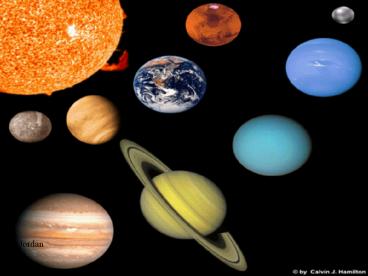Solar System - PowerPoint PPT Presentation
1 / 17
Title: Solar System
1
By Jordan
2
Sun
- The sun contains nearly all the matter in the
solar system. Heat, light, and other forms of
energy stream outward in all directions from its
surface.
3
Mercury
Mercury is so close to the sun that its
temperature is about 425 degrees Celsius (800
degrees Fahrenheit). Mercury does not have enough
gravity to hold an atmosphere.
4
Venus
- Venus is a hot planet with a thick atmosphere
of carbon dioxide. Venus has a surface
temperature of about 480 degrees Celsius (900
degrees Fahrenheit), which is much too hot for
life.
5
Earth
- With its oxygen-rich atmosphere and liquid
surface water, earth may be the only planet in
the solar system able to support life.
6
Mars
- Mars appears red because of the iron oxide,
or rust, in its soil. Like Earth, Mars has frozen
ice caps at its poles and deserts.
7
Jupiter
- Jupiter is the largest planet in the solar
system. Unlike the other planets, Jupiter is a
giant ball of liquid hydrogen and helium
surrounded by several thin rings.
8
Saturn
- Saturn is another gas giant. Saturn has 18 moons
and a huge system of rings, which are made up of
ice chunks of varying sizes.
9
Uranus
- Uranus has more moons than any other planets
and ten thin rings. It is tilted so far on its
axis that it rotates on its side.
10
Neptune
- Neptune also has thin rings. Its color is
similar to that of Uranus. One of Neptunes
moons, Triton, is the largest in the solar system.
11
Pluto
Pluto is small and icy. Part of Plutos orbit
passes inside that of Neptune, so at that time
Neptune is the planet farthest from the sun.
12
Meteorites
- A meteoroid is matter revolving around the sun or
any object in interplanetary space that is too
small to be called an asteroid or a comet. Even
smaller particles are called micrometeoroids or
cosmic dust grains, which includes any
interstellar material that should happen to enter
our solar system. A meteorite is a meteoroid that
reaches the surface of the Earth without being
completely vaporized.
13
Asteroids
Asteroids are chunks of rock that have been
described to look like giant potatoes in space.
Some are as large as small planets. Others are
the size of a basketball. Some scientists
hypothesize that asteroids represent matter that
failed to form a planet.
14
Comets
- Comets are balls of ice and rock. They circle
the sun from two regions beyond the orbit of
Pluto. Glowing clouds surround most comets. Tails
of gas can often be seen trailing them as their
orbits take them near the sun.
15
How do we know about all the Planets?
- We use current technology to update knowledge
about the earth and the solar system. Some
examples of this technology are telescopes,
satellites, space probes, and space shuttles.
16
Instruments used to observe the universe
- A telescope is an instrument that magnifies, or
makes larger, distant objects. We can study the
moon and other objects in space by using a
telescope. - A satellite is any natural body, like the moon,
or artificial object that orbits another object.
An example of an artificial satellite is Sputnik.
- A space probe is a robot vehicle used to explore
deep space. Voyager 1 and Voyager 2 are two space
probes that have been launched. - Space shuttles have been used since 1981. They
provide a place to launch, bring back, and repair
satellites.
17
- By Jordan
- Resources
- Solar System Views www.solarviews.com
- Harcourt Science Book for 5th Grade
- Flaming Text www.flamingtext.com
Mrs. Heislers Web Page































